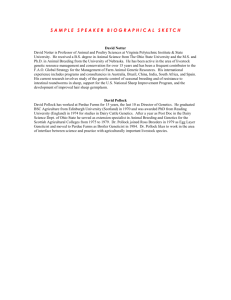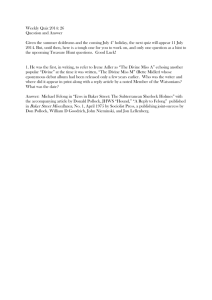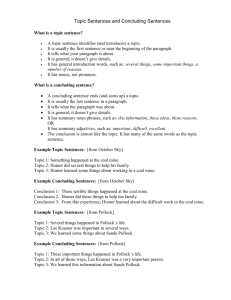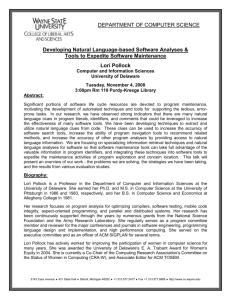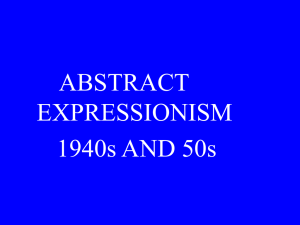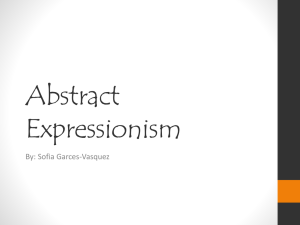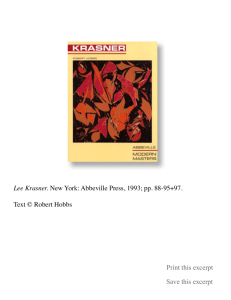Jackson Pollock, Lee Krasner and a New Concept of Nature
advertisement
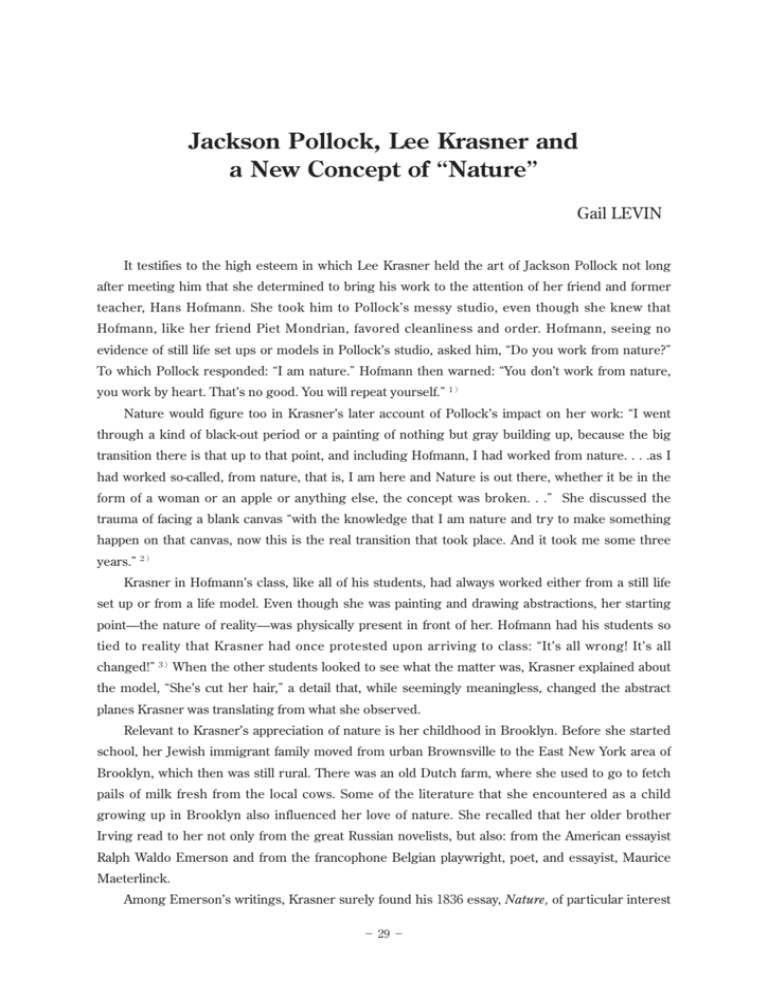
Jackson Pollock, Lee Krasner and a New Concept of Nature Gail LEVIN It testifies to the high esteem in which Lee Krasner held the art of Jackson Pollock not long after meeting him that she determined to bring his work to the attention of her friend and former teacher, Hans Hofmann. She took him to Pollock’s messy studio, even though she knew that Hofmann, like her friend Piet Mondrian, favored cleanliness and order. Hofmann, seeing no evidence of still life set ups or models in Pollock’s studio, asked him, Do you work from nature? To which Pollock responded: I am nature. Hofmann then warned: You don’t work from nature, you work by heart. That’s no good. You will repeat yourself. 1) Nature would figure too in Krasner’s later account of Pollock’s impact on her work: I went through a kind of black-out period or a painting of nothing but gray building up, because the big transition there is that up to that point, and including Hofmann, I had worked from nature. . . .as I had worked so-called, from nature, that is, I am here and Nature is out there, whether it be in the form of a woman or an apple or anything else, the concept was broken. . . She discussed the trauma of facing a blank canvas with the knowledge that I am nature and try to make something happen on that canvas, now this is the real transition that took place. And it took me some three years. 2) Krasner in Hofmann’s class, like all of his students, had always worked either from a still life set up or from a life model. Even though she was painting and drawing abstractions, her starting point̶the nature of reality̶was physically present in front of her. Hofmann had his students so tied to reality that Krasner had once protested upon arriving to class: It’s all wrong! It’s all changed! 3) When the other students looked to see what the matter was, Krasner explained about the model, She’s cut her hair, a detail that, while seemingly meaningless, changed the abstract planes Krasner was translating from what she observed. Relevant to Krasner’s appreciation of nature is her childhood in Brooklyn. Before she started school, her Jewish immigrant family moved from urban Brownsville to the East New York area of Brooklyn, which then was still rural. There was an old Dutch farm, where she used to go to fetch pails of milk fresh from the local cows. Some of the literature that she encountered as a child growing up in Brooklyn also influenced her love of nature. She recalled that her older brother Irving read to her not only from the great Russian novelists, but also: from the American essayist Ralph Waldo Emerson and from the francophone Belgian playwright, poet, and essayist, Maurice Maeterlinck. Among Emerson’s writings, Krasner surely found his 1836 essay, Nature, of particular interest − 29 − 立命館言語文化研究 24 巻 3 号 because he called for one’s own fresh sight and experience, not relying on that of others. He asked: The foregoing generations beheld God and nature face to face; we, through their eyes. Why should not we also enjoy an original relation to the universe? Why should we not have a poetry and philosophy of insight and not of tradition, and a religion by revelation to us, and not the history of theirs? Emerson defined the very concept of nature: Philosophically considered, the universe is 4) composed of Nature and the Soul. Strictly speaking, therefore, all that is separate from us, all which Philosophy distinguishes as the NOT ME, that is, both nature and art, all other men and my own body, must be ranked under this name, NATURE. Krasner would have also responded to Emerson’s conception of how art intersects with nature: Nature, in the common sense, refers to essences unchanged by man; space, the air, the river, the leaf. Art is applied to the mixture of his will with the same things, as in a house, a canal, a statue, a picture. 5) When Irving read from the translations of Maeterlinck to Lena, as she was then still called, she would also have found encouragement for her love of nature. Maeterlinck’s News of Spring and Other Nature Studies, including The Intelligence of Flowers, which was published in an American edition in 1913, could have reinforced the young Krasner’s love of flowers. Not only do the irises, roses, and daisies that she recalled from her childhood all appear in this volume, but there is also an elaborate discussion of the lettuce leaf’s remarkable ability to defend itself against slugs, recalling the unusual metaphor of the lettuce leaf, which she drew upon to explain her art in the statement for her first retrospective in 1965: Painting, for me, when it really happens’ is as miraculous as any natural phenomenon --as, say, a lettuce leaf. By happens,’ I mean the painting in which the inner aspect of man and his outer aspect interlock. 6) Like Krasner, Pollock had spent some of his childhood in rural areas. Born in Cody, Wyoming, by the time he was one, his family had settled on a small farm in Phoenix, Arizona. Economic fragility caused frequent displacements from the time Jackson was four years old. At that time, his family relocated to rural areas in southern California. Suf fice it to say that Pollock was as acquainted with nature as any boy growing up on a farm would be. As a young man, Pollock’s odd jobs included working as a lumberjack at Big Pines, California, where he cut wood in the summer of 1931. In 1930, Pollock had begun to study art at the Art Students League with Thomas Hart Benton, who encouraged the painting of local color and the American scene. On one sketching trip, Jackson wrote to his brother Charles that The country began getting interesting in Kansas̶the wheat was just beginning to turn and the farmers were making preparation for harvest. 7) When Pollock and Krasner met, they were both living in New York City. During the fall of 1942, he was living at 46 East 8th Street in Greenwich Village in the heart of Manhattan, and Krasner had been living just a block away before she moved in with him, following a courtship triggered by their participation in the same group show the previous Januar y. With Krasner’s encouragement and help, Pollock’s career was launched with Peggy Guggenheim as his dealer. When asked in 1944 if he preferred living in New York to his native West, he allowed that he − 30 − Jackson Pollock, Lee Krasner and a New Concept of Nature (LEVIN) preferred New York’s stimulating influences, but noted I have a definite feeling for the West: the vast horizontality of the land, for instance; here only the Atlantic ocean gives you that. 8) During the summer of 1945, Krasner and Pollock visited their friends Reuben and Barbara Kadish on the rural Eastern end of Long Island in New York State. The two couples were sharing a rustic cottage in the Springs, a hamlet of the town of East Hampton. Their relaxed time there inspired Krasner to suggest to Pollock that they move out from New York City and live there year round. After initially rejecting the idea, Pollock became determined to do it. Anticipating life in a small town led the couple to marry. In November 1945, they moved out to a house along Accabonac Creek in Springs, arriving in the midst of a Northeaster. As they settled into country living and small-town life, the area prompted them to swim and take walks along the beach and through the fields. Eventually, they began to garden together, growing some of their food. Their new immersion in nature shows up in art works by each of them. Instead of recording nature that they observed, Pollock and Krasner expressed what nature made them feel. The impact of some of the natural phenomena in the new environment is also evidenced in some of the titles that they chose and in some of the images themselves. The Native American name, Accabonac Creek, itself became the title of a series of paintings by Pollock in 1946. He called another of his series of abstract works at this time, Sounds in the Grass, which includes paintings with titles like Earth Worms & Croaking Movement that refer to nature. Krasner reflected, One thing Jackson and I had in common was experience on the same level …feeling the same things about landscape, for instance, or about the moon. He did a series around the moon. He had mysterious involvement with it. I had my own way of using that material. Very often I would get up at two or three and come out on the porch and just sit in the light here. 9) Away from the city’s electric lights, the moon came into its own. The stars seemed much brighter. Out of this experience, came such works as Krasner’s 1947 canvas, Night Life [Fig.1], one of her Little Image series, as well works by Pollock such as Constellation (1946) [Fig.2] or Comet (1947). Pollock eventually dropped naming his pictures and for a time utilized only numbers to refer to them. Number 5 (1948) by Pollock attracted the artist Alfonso Ossorio, heir to a Philippine sugar fortune, who purchased it in Januar y 1949, from the Betty Parsons Galler y, where both were showing. Ossorio also bought a home in East Hampton in 1951, because of his friendship with Pollock and Krasner, though Ossorio also spent time in Paris, where he befriended the avant-garde painter and sculptor Jean Dubuffet and amassed a collection of his work. The extent and direction of artistic influence among Ossorio, Pollock, and Krasner has not been suf ficiently studied. Scholars have credited artists Robert Mother well and others with introducing Zen ideas to the artists of the New York School, but it is likely that Ossorio also had some part in disseminating Zen concepts in East Hampton in spring 1952, when he began to see Pollock and Krasner regularly. Meanwhile, Ossorio was actively pursuing his interest in Asian culture, including Japanese art and Zen, and it’s likely he discussed Zen concepts of action with Pollock. − 31 − 立命館言語文化研究 24 巻 3 号 Among the books Ossorio acquired that year was Langdon Warner’s new The Enduring Art of Japan [Fig.3].10) Warner was a Har vard professor, Asian ar t exper t, and one-time student of Okakura Tenshin, a Japanese scholar who became the first head of the Boston Museum of Fine Art’s Asian art division in 1910.11) Warner was a raconteur, and he taught art history at Harvard when Ossorio was a student. His old professor’s book made Ossorio focus on Zen concepts with which he was almost certainly already familiar from Daisetz T. Suzuki’s 1934 book, Introduction to Zen Buddhism, a book much read in art circles in New York during the 1950s, and most probably by Ossorio while still at Harvard. Warner’s introduction notes how In the practice of putting down their paintings in ink on paper Zen artists discovered that the principle of muga (it is not I that am doing this) opens the gate for the necessar y essential truth to flow in. When the self does not control the drawing, meaning must. The principle runs all through Zen teachings especially where action is involved. Suzuki had written in his earlier book that in a state of muga the unconscious is realized and described a state of ecstasy in which there is no sense of I am doing it. In muga, he explained, 12) your natural faculties [are] set in a consciousness free from thoughts, reflections, or affectations of any kind. 13) In the summer of 1952, the art critic Harold Rosenberg sometimes joined his East Hampton friends Pollock, Krasner, and Ossorio when they talked about art.14) It appears that hearing about muga influenced the critic Harold Rosenberg as he developed his concept of action in his article The American Action Painters, which appeared in Art News in December 1952. Rosenberg wrote, At a certain moment the canvas began to appear to one American painter after another as an arena in which to act ̶ rather than as a space in which to reproduce, re-design, analyze, or express’ an object, actual or imagined. 15) Rosenberg’s work on this landmark article, in which he first named action painting, coincides with the publication of Warner’s new book. Rosenberg went on to evoke the Zen action that is consciousness free from thoughts in this same article, when he observed that The painter no longer approached his easel with an image in his mind; he went up to it with material in his hand to do something to that other piece of material in front of him. The image would result from his encounter. 16) Gossip circuits buzzed when Rosenberg’s The American Action Painters appeared. The article created stir that pained Pollock, who felt personally attacked by Rosenberg’s thesis on action painting, even though Rosenberg did not identify him by name. When Rosenberg poked fun in his article at an unnamed artist who claimed that another was not modern because he works from sketches, he was describing an attitude held by both Krasner and Pollock, neither of whom worked from sketches in making paintings. Rosenberg wrote, A painting that is an act is inseparable from the biography of the artist. The painting itself is a moment’ in the adulterated mixture of his life….The new painting has broken down every distinction between art and life. 17) This statement implicitly attacked the alcoholic Pollock, whose public behavior was too often dysfunctional, while his paintings had gained him both admiring and derisive attention. Rosenberg − 32 − Jackson Pollock, Lee Krasner and a New Concept of Nature (LEVIN) argued that what gives the canvas its meaning is the way the artist organizes his emotional and intellectual energy as if he were in a living situation. 18) Rosenberg taunted Pollock even more directly by discussing artists who, lacking verbal flexibility….speak in a jargon; among the examples he gave of an artist describing his work was, It doesn’t reproduce Nature; it is Nature, which paraphrases Pollock’s notorious retor t to Hofmann’s advice.19)Rosenberg may have revealed more than he intended when he stated a piece of wood found on the beach becomes Art….Modern Art does not have to be actually new; it only has to be new to somebody to the last lady who found out about the driftwood… 20) Driftwood would have been on Rosenberg’s mind if he had seen the photograph that Herbert Matter had once taken of his young wife Mercedes nude on the beach [Fig.4]. Matter had used driftwood to frame Mercedes’s breast. Pollock had owned a copy of the photo. In this regard, Rosenberg’s apparently dismissive reference to the last lady… may be an erotic wink to Mercedes, with whom he was then having an affair at the same time that he was also seeing Elaine de Kooning, Bill’s estranged wife. Hurt by Rosenberg’s article, Pollock told his friend Jeffrey Potter, The corner they got me in is more like what Harold Rosenberg wrote about Action Painters. . . .How does it go? Vanguard painters have a zero audience; the work gets used and traded but not wanted. 21) Rosenberg later wrote: Art in the service of politics declined after the war, but ideology has by no means relaxed its hold on American painting. Zen, psychoanalysis, Action art, purism, anti-art̶and their dogmas and programs̶have replaced the Marxism and regionalism of the thirties. It is still the rare artist who trusts his work to the intuitions that arise in the course of creating it. 22) Yet, Rosenberg’s rival, the critic Clement Greenberg, wrote that [Pollock] laughed at the whole notion of Action Painting,’ which he thought, when sober, a purely rhetorical fabrication ….Pollock was the most intelligent painter I’ve known at first hand, one of the most learned & truly sophisticated; without his intelligence, he would not have become the artist he was. 23) Greenberg, whom Krasner introduced to her husband, promoted Pollock’s work, but never wrote about hers. Though he wrote about Pollock’s nature-based works like Autumn Rhythm (Number 30) (1950) [Fig.5], Greenberg was not a particularly acute observer of nature. Another contemporary critic who was, the artist Fairfield Porter, wrote in Art News that some of Krasner’s largest collages of 1955 with titles like Stretched Yellow, Milkweed [Fig.6] and Blue Level, are like nature photographs magnified. The irregular shapes and simple colors of the former paintings, as well as the bumpily irregular surface of Broken Grey, like a messed-up beach of pebbles̶all these things slow the pictures up.’ 24) He proposed: Krasner’s art, which seems to be about nature, instead of making the spectator aware of a grand design, makes him aware of a subtle disorder greater than he might otherwise have thought possible. 25) After Pollock’s sudden death in a car crash in 1956, Krasner painted bold and upbeat works in a series she called Earth Green. Her impulse was to reach out and boldly embrace life, which had so swiftly left Pollock. Her frequent preoccupations include an emphasis on nature. She sometimes − 33 − 立命館言語文化研究 24 巻 3 号 hints of birth, destruction, and regeneration. Nearly two decades later, Krasner spoke about the paintings in this series: I can remember when I was painting Listen [Fig.7], which is so highly keyed in color̶I’ve seen it many times since and it looks like such a happy painting–I can remember that while I was painting it I almost didn’t see it, because tears were literally pouring down. 26) The bright colors and biomorphic forms evoke a figure in a garden, an activity that she had shared with Pollock after they first moved to Springs. In 1960, Krasner titled a large horizontal canvas, painted in an umber monochromatic palette, The Eye is the First Circle [Fig.8]. The opening lines of Emerson’s Circles appealed to Krasner’s deep appreciation of nature and patterns: The eye is the first circle; the horizon which it forms is the second; and throughout nature this primar y figure is repeated without end. 27) Although Krasner had focused on disembodied eyes as early as the 1930s, when she was briefly under the influence of Surrealism, she said that she titled the painting after it was finished, and then I saw those eyes, too. 28) She was painting these umber works at night, working under artificial lights because she was suffering from insomnia. In 1968, when Krasner was once again engaged with vivid color, she produced a painting she called Pollination [Fig.9], which suggests that she recalled what she knew of Maeterlinck’s book, The Life of the Bee. Maeterlinck wrote the foragers go forth, in long black files, to return, in less than three minutes sometimes, laden with nectar and pollen; streets are swept, parasites and marauders killed or expelled; and the hive soon resounds with the gentle, monotonous cadence of the strange hymn of rejoicing. 29) Pollination is the transfer of pollen from a stamen to a pistil of a flower in order to achieve fertilization. Bees play an important role in pollinating flowering plants, and are the major type of pollinator in ecosystems that contain flowering plants. Krasner’s own comment about the canvas she named Pollination suggests that her associations with this topic dated from her childhood when her brother read Maeterlinck to her: I can remember walking across vacant lots, on my way to school and my enchantment at seeing and picking clover, buttercups and dandelions. I’m sure that this memory among other things is in Pollination.30) If we also look at her canvas, Mysteries, of 1972 [Fig.10], we see that the bright colors and forms also suggest her love of gardens, even evoking the forms and colors of specific flowers such as bleeding hearts (scientific name: Dicentra Spectabilis) or the shape of insects such as the lightning bugs or fireflies (scientific name: Photinus sp.) that illuminate a Long Island summer night. Were these forms conscious choices? Perhaps not, but they appear to underscore Krasner’s engagement with nature and the infinite mystery of its forms. Krasner’s abstract paintings, Vigil of 1960 [Fig.11] and Portrait in Green of 1969, each appear to contain a face that emerges from her gestural brushstrokes [Fig.12]. These two faces recall linear images of the Buddha in eighth-centur y Japanese paintings from Nara such as those reproduced in Warner’s book on Japanese art that Ossorio owned [Fig.13, 14]. In 1956, the artist Paul Jenkins gave Pollock and Krasner philosopher Eugen Herrigel’s book, Zen in the Art of Archery, first translated into English just three years earlier. Krasner wrote herself a note after − 34 − Jackson Pollock, Lee Krasner and a New Concept of Nature (LEVIN) reading it: I want to talk about my self-destruction my disgust & stupidity̶ (waiting ̶paralysis) waiting ̶& trapped by ...Zen & the mastery of Archery... began to breathe more easily & dove in̶point I made about painting̶let it come to me. 31) In her desperate search for inner peace in the face of Pollock’s turmoil, Krasner had been thinking about Zen concepts. Krasner’s self-analysis included awareness of her involvement with nature. She expressed this in March 1974, when Miriam Schapiro’s students in the Feminist Ar t Program at California Institute of the Arts reached out to her, requesting that she write a Letter to a Young Woman Artist. The letter could have been about your experiences, or advice, or whatever feelings you might wish to express. She responded by having Donald McKinney, her gallery’s president, send in a quotation by her for the students’ publication: On a questioning of my newer work being more organic and close to nature images, I think for every level you go higher, you slip down one or two levels and then come back up again. When I say slip back, I don’t mean that detrimentally. I think it is like the swing of a pendulum rather than better or back, assuming that back means going down. If you think of it in terms of time, in relation to past, present and future, and think of them all as a oneness, you will find that you swing the pendulum constantly to be with now. Part of it becomes past and the other is projection but it has got to become one to be right now. I think there is an order, but it isn’t better, better, best. I don’t believe in that kind of scaling. To Evelyn Bennett, a local reporter in Southampton, New York, where she was having a summer show, Krasner explained that an underlying philosophy of her work for the series related to the totality of life̶ what she considered nature. There are elements of nature’ in my work, she said, but not in the sense of birds and trees and water. When I say nature I might mean energy, motion, everything that’s happening in and around me. That’s what I mean by nature. So you’re really talking about everything living, really? Bennett rejoined. Yes and death too, Krasner replied, things that are dead; everything. When told, There’s something very religious about that, Krasner returned, Of course̶art is religious; it has to be. That’s what I think, anyway. These people who do paintings of trivia̶it’s a waste of my time. 32) What she meant by paintings of trivia was subject matter found in Pop Art such as soup cans, comics, and other such themes taken from popular culture. In her engagement with nature, Krasner saw a much higher purpose for her own art than that. She was much more interested in the spiritual side of art in the same sense that Wassily Kandinsky was at the beginning of the twentieth century.33) Notes 1)Lee Krasner interview with Dorothy Seckler, December 14, 1964, in the Lee Krasner Papers (LKP), − 35 − 立命館言語文化研究 24 巻 3 号 Archives of American Art (AAA), Smithsonian Institution, Washington, D.C. 2)Lee Krasner to Dorothy Seckler, interview of November 2, 1964, AAA. Robert Hobbs, Lee Krasner, pp. 64-66, attributes the grey slabs to Krasner’s hearing about the Holocaust, but this seems unlikely. If anything af fected her beyond the impact of Pollock’s ar t, it would have been her father’s death in November 1944. 3)Lee Krasner related by Perle Fine, Lee’s friend and classmate, quoted in Kathleen L. Housely, Tranquil Power: The Art and Life of Perle Fine (New York: Midmarch Arts Press, 2005), pp. 36-37. 4)Ralph Waldo Emerson, Nature, 1836, p. 1. 5)Ralph Waldo Emerson, Nature, 1836, p. 1. 6)Lawrence Campbell, Of Lilith and Lettuce, Art News, March 1968, p. 62. This statement exists in Krasner’s hand in her papers, AAA, roll 3774, frame 703. 7)Jackson Pollock to Charles Pollock, quoted in Francis V. O’Connor, Jackson Pollock (New York: The Museum of Modern Art, 1967), p. 16. 8)Jackson Pollock to Charles Pollock, quoted in O’Connor, Jackson Pollock, p. 16. 9)Lee Krasner quoted in Eleanor Munroe, Originals: American Women Ar tists (New York: Simon & Schuster, 1979), p. 114. 10)Langdon Warner, The Enduring Art of Japan (Cambridge, MA: Harvard University Press, 1952), copy inscribed on the half-title page in the artist’s hand: Alfonso Ossorio ’52 East Hampton, collection of the author. 11)See Constance J.S. Chen, Transnational Orientals: Scholars of Art, Nationalist Discourses, and the Question of International Authority, Journal of Asian American Studies, 9, no. 3 (2006), pp. 215-242. 12)See William Barrett, ed. Zen Buddhism: Selected Writings of D. T. Suzuki (New York: Anchor Books, 1956), p. 349. 13)Ibid. 14)Author’s inter view on Febr uar y 16, 2011, with Mike Solomon, founding director of the Ossorio Foundation, who met Ossorio through his father, artist Syd Solomon. 15)Harold Rosenberg, The American Action Painters, Art News, December 1952, p. 22. 16)Ibid., p. 22. 17)Ibid., p. 23. 18)Ibid., p. 23. 19)Ibid., p. 48. 20)Ibid., p. 49. 21)Jackson Pollock quoted in Jeffrey Potter, To A Violent Grave: An Oral Biography of Jackson Pollock (Wainscott, New York: Pushcart Press, 1985), p.169. 22)Harold Rosenberg, Painting is a Way of Living, The New Yorker, February 1, 1963; reprinted as De Kooning: 1, Painting is a Way, in Harold Rosenberg, The Anxious Object: Art Today and Its Audience (New York: Horizon Press, 1966), p. 90. 23)Clement Greenberg to Don Casto, letter of February 14, 1964, in response to Casto’s questions; Clement Greenberg papers, Getty Research Institute, Los Angeles, California. 24)F.P. [Fairfield Porter], Lee Krasner, Art News, November 1955, p. 66. My copy labeled by Krasner herself in her hand when she gave it to me. 25)Ibid. 26)Richard Howard, A Conversation with Lee Krasner, 1978, in Lee Krasner Paintings 1959-1962, The Pace Gallery, 1979, n.p. − 36 − Jackson Pollock, Lee Krasner and a New Concept of Nature (LEVIN) 27)Ralph Waldo Emerson, Circles, 1843, reprinted in Ralph Waldo Emerson, Essays and Lectures (New York: Library of America, 1983), pp. 401-414. 28)Lee Krasner to the author, 1980; Howard, 1978; Dorothy Seckler interview, December 14, 1967, AAA. 29)Maurice Maeterlinck, The Life of the Bee (New York: Dodd & Mead, 1914), p. 28. Translated by Alfred Sutro and first published May, 1901. 30)A. T. Baker, Art: Out of the Shade, Time, November 19, 1973. Lee Krasner wrote out this recollection, which is found in her papers, AAA, roll 3774, frame 701. 31)Note in Lee Krasner’s hand in Lee Krasner Papers, AAA. Eugen Herrigel, Zen in the Art of Archery (1953), collection of the Pollock-Krasner House, East Hampton, NY. 32)Evelyn Bennett, Homage to be Famous Husband: Lee Krasner, An Ar tist in her Own Right, (Bridgehampton, NY: Bridgehampton Sun, August 20, 1980, in LKP, AAA. Roll 3776, frames 1298-99. 33)See Wassily Kandinsky, Concerning the Spiritual in Art (New York: Wittenborn & Co., Inc., 1947). − 37 −


